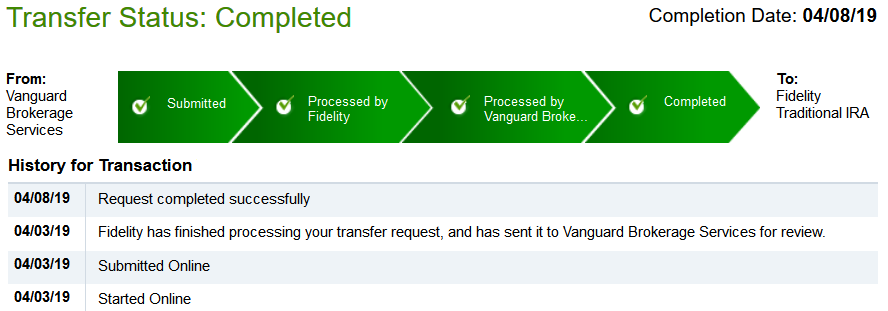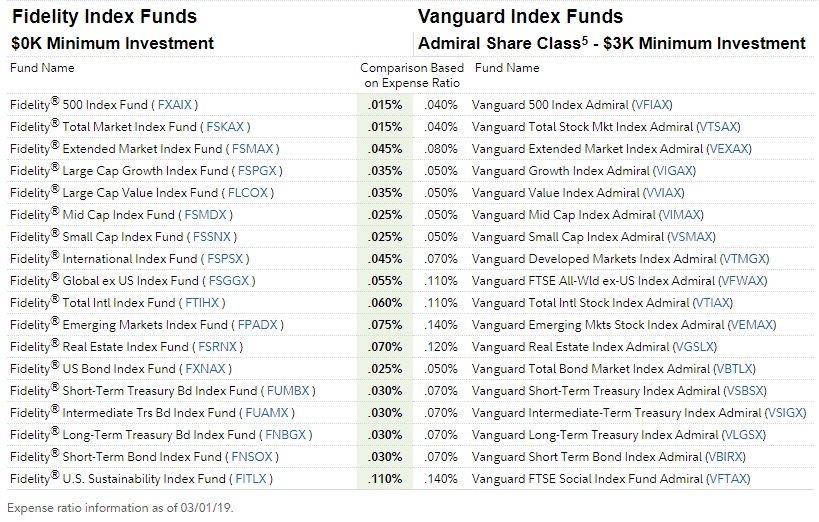Transferring Retirement Assets from Vanguard to Fidelity
 I recently completed a six-figure transfer of retirement assets from Vanguard to Fidelity. The transfer is part of an account consolidation effort I put in motion last year to simplify our finances.
I recently completed a six-figure transfer of retirement assets from Vanguard to Fidelity. The transfer is part of an account consolidation effort I put in motion last year to simplify our finances.
The need to consolidate accounts became apparent when we started working on our family estate plan. We’re coming close to finally completing our estate plan (after a year of procrastination), so it’s time to get the financial accounts in order.
The idea is to have a one-page printed piece of paper with all of our accounts in one place to make it easy should something happen to me since I take care of all the money stuff. Fewer accounts all under one roof also makes it easier to analyze and rebalance assets properly.
I’ve already closed several DRIPs, a brokerage account, and a few savings accounts.
But I’m now in the process of transferring all of my primary assets into Fidelity. The accounts include my Vanguard rollover IRA from my previous employer and, eventually, my long-time TD Ameritrade taxable account (where most of my dividend stocks are).
As I’ve written about before, more than 70% of my equity assets are in mutual funds in retirement accounts. However, I’ve focused my writing mostly on my taxable dividend portfolio over the years.
The balance of my retirement accounts is accelerating rapidly because of the compounding effect on my existing holdings and due to aggressive maximization of tax-advantaged accounts.
On the blog, I want to start focusing more attention toward my retirement accounts going forward, in addition to highlighting the multiple income streams that I’ve shared since the start of RBD.
Why Fidelity?
A portion of my retirement money has been with Fidelity since 1998 when I started my first real job out of college. I’ve always been happy with them.
I have a traditional IRA that was my first 401(k). Then I opened a Roth IRA about a decade ago.
My current employer uses Fidelity to administer a 403(b) and a 401(a) plan.
Mrs. RBD has a traditional IRA rolled over from her previous employer and a Roth IRA we opened shortly after getting married.
That’s six different accounts, each with a specific purpose — all at Fidelity.
I also had a rollover IRA at Vanguard that was my crappy 401(k) plan from my previous employer. But it still grew to a healthy six-figure retirement account over 14 years. It was four times larger than my other Fidelity accounts combined.
In hindsight, I should have transferred it directly to Fidelity or TD Ameritrade when I lost my job. But instead, I moved the old 401(k) to Vanguard for a few reasons.
First, I was tentatively expecting to work for a company that used Vanguard as their retirement administrator. The job was very likely to work out, but I found a better gig before the position opened for me.
Second, people rave about Vanguard, so I was curious and confident they were a solid choice.
I was also in a hurry to get the money out of the crappy plan and into better investments. I didn’t know how long I’d be unemployed, and I wanted a clean break from my former employer and everything about them.
The Transfer from Vanguard to Fidelity
A few weeks back, I was exploring my Fidelity accounts and discovered some cool features of the platform. It allows the user to connect accounts from external banks and brokerages to get a big picture view of your investments.
I linked all of my investment accounts and liked the consolidated view and reports. Then I noticed Fidelity has budgeting software built into their platform as well.
Very similar to Mint.
Then it dawned on me. I’ve always been happy with Fidelity. They’ve heavily invested in their desktop and mobile platforms. Customer service has always been helpful, professional, and fast. And I needed to consolidate accounts to clean up our financial lives in coordination with our estate planning.
So I spoke to a few Fidelity and Vanguard reps over the next few weeks to make sure the transfer would complete without any issue. Sometimes certain funds must be liquidated before the transfer. I wanted to avoid liquidation.
It turns out that Vanguard’s Admiral funds can transfer without liquidation. Fidelity offered me free trades to avoid any sales fees on the Vanguard while switching to Fidelity funds.
I thought it through for a few more days. Then I initiated the transfer.
Always initiate transfers on the receiving broker side. I did it all online, and it took less than five minutes to set it in motion. I put the money into my existing traditional IRA.
After 18 months with Vanguard, the transfer to Fidelity took five days to complete.

Comparing Vanguard and Fidelity
Vanguard and Fidelity are two of the largest employer retirement plan administrators. Both are also popular with individual investors looking to own low-cost index funds.
Vanguard popularized the passive investing craze. But Fidelity has created a portfolio of passively managed index funds to compete.
Fidelity has aggressively lowered minimum investments and expense ratios to attract new customers.

Both companies now have complimentary index funds to satisfy the needs of everyone. But there are notable differences with the funds and platforms.
Minimums and Fees
In August 2018, Fidelity cut the minimum initial investment amounts and fees on several of its mutual funds. The lower minimums (most at $0) give them a competitive edge over Vanguard.
Its expense ratios are also now lower than many of Vanguards signature index funds (see above).
For example, Vanguard’s Total Stock Market Index Fund (VTSAX) has a minimum initial investment of $3,000 and an expense ratio of 0.04%.
Fidelity’s Total Market Index Fund (FSKAX) has a minimum initial investment of $0.00 and an expense ratio of 0.015%.
The funds invest mostly in the same assets and perform in tandem.
We’re talking about very smalls differences in fees, so lower expense ratios are not a reason to switch to Fidelity from Vanguard. With a new aggressive pricing strategy, Fidelity has indeed declared itself a leader in low-cost retirement investing.
Desktop Platform
Vanguard’s desktop platform feels old-fashioned to me, but overall it’s OK. Admittedly, I didn’t spend much time on the website because I only made some purchases and let them ride.
Fidelity is a more modern platform. They released a significant upgrade a few years ago and the platform is easier to use. However, some features were left untouched and sometimes you’re passed back and forth between new pages and legacy pages.
Mobile
Vanguard’s mobile app is highly functional. You can do whatever you need to do. But it is very clunky. They recently invited some customers to become beta testers of their new mobile platform, so I suspect a major upgrade is on the horizon.
Fidelity’s mobile app was completely revamped a few years ago and is one of the best financial apps I’ve used anywhere. It’s easy to navigate between all of my accounts and feels far more modern.
There’s a news feed that I don’t find that useful. Most of what I care about is ease of research and checking out what stock prices are doing midday.
Bottom Line
Both Fidelity and Vanguard are top financial institutions for your money. They are big and have the cash to invest in customer service and improved technology.
You can’t go wrong with either one.
Keep in mind, both started as mutual fund companies and have adapted to become full-service online brokers. If your primary intent is to invest in mutual funds, investing directly with the company is the way to go.
Big online brokers such as TD Ameritrade offer access to no-cost mutual funds and ETFs too. Newer online brokers such as M1 Finance and Betterment encourage customers to utilize index fund equivalent ETFs for index investing, which works similarly.
My preference is to put my retirement money into mutual funds and keep my hands off over the years. I manage my dividend accounts more actively.
Transferring Dividend Stocks from TD Ameritrade to Fidelity
My retirement accounts are now completely transferred from Vanguard to Fidelity. But I still have additional taxable accounts with TD Ameritrade and the no-fee broker, M1 Finance. These two accounts are the focus of my published dividend portfolio.
At this stage, I am planning to transfer the TD Ameritrade account to Fidelity when I’m ready.
My TD Ameritrade dividend growth portfolio has also grown to a six-figure account. But I’m not an active trader. I buy stocks and collect dividends. Then I reinvest the dividends into more dividend-paying stocks. I’ve almost always been happy with them.
I don’t need a fancy trading platform. My priority now is to simplify my life a bit. Fidelity is an equally capable online brokerage for my needs, so it makes sense to move my money there.
Fidelity charges $4.95 per stock trade while TD Ameritrade charges $6.95 is now commission-free as of October 2019!
The only hesitation I have is the cost basis data on record at TD Ameritrade. When I transferred my decades-old DRIPs (including Chevron, Coca-Cola, Emerson, and Verizon), I had to update the cost basis from my records. Since these were DRIPs, there were dozens of transactions for each.
I’m afraid that when I transfer my holdings, the cost basis will not be transferred correctly or at all. I’ve seen this screwed up many times. I will back up my cost basis very carefully in case I have to resubmit the data.
Another consideration is that my TD Ameritrade account is an individual account. I want to make this a joint portfolio, adding Mrs. RBD to the account. That will involve a few extra steps. A bit of a headache, but another smart estate planning maneuver.
What About M1 Finance?
I’m a big fan of the online broker M1 Finance. Like Robinhood, M1 Finance charges no fees to buy and sell stocks and ETFs. Investing on M1 Finance is not the same as most online brokers, but I like the intuitiveness of building a dividend portfolio with pies.
I’ve created an M1 pie of 10 dividend stocks that I contribute to every month. It’s a convenient way to dollar cost average into high-quality dividend growth stocks over time.
Dividends are easily reinvested back into the portfolio, much like DRIPs, but more flexible. I always liked dollar cost averaging with DRIP investing, but now there’s a better way to accomplish the same thing. That’s my primary reason for keeping this account active. Someday, I may transfer those assets to Fidelity as well.
I recommend M1 Finance for investors looking to build a long-term dividend growth or index ETF portfolio. RBD is an affiliate partner with M1 Finance and recommends several investing platforms.
You can open individual accounts or IRAs, making it a good choice for many investors. The no-fee model, I do believe, is the future, today.
However, I’ve chosen not to use my M1 Finance account for my tax-advantaged investing. Fidelity is a long-established company in the space, and I have built a 20-year relationship with them, and I’ve never had a reason to leave. Plus, my employer-sponsored accounts are there, and I expect to remain for a while.
On top of that, the M1 Finance platform does not support mutual funds.
So for now, I’m going to continue investing on M1 Finance to build my dividend income, and keep the index investing at Fidelity.
The Next Steps
One reason I’ve shared very little about our retirement accounts is they’ve been disorganized. We’ve owned several different index funds, ETFs, and managed mutual funds that give us the same exposure to a broad array of stocks.
I’m now in the process of aligning the investments across all six Fidelity accounts. That means selecting one fund that covers each asset type I want to have exposure to (a total market stock fund, international stock fund, domestic bonds, etc.).
It’s been a more involved process than I expected, especially bringing the Vanguard funds into the mix.
Once the alignment of investments is complete, I’ll be better equipped to analyze our retirement portfolio and make adjustments as needed. Under one roof, the process will be much more efficient.
It will also make it easier to share the details of my retirement investment allocation percentages on the blog, giving readers a complete view of my total investment portfolio. I intend to share this information by mid-year.
Read more: FSKAX vs VTSAX comparison
Have you done a transfer from Vanguard to Fidelity or vice versa? How did it go?
Photo by lightsource via DepositPhotos used under license

Craig is a former IT professional who left his 19-year career to be a full-time finance writer. A DIY investor since 1995, he started Retire Before Dad in 2013 as a creative outlet to share his investment portfolios. Craig studied Finance at Michigan State University and lives in Northern Virginia with his wife and three children. Read more.
Favorite tools and investment services right now:
Sure Dividend — A reliable stock newsletter for DIY retirement investors. (review)
Fundrise — Simple real estate and venture capital investing for as little as $10. (review)
NewRetirement — Spreadsheets are insufficient. Get serious about planning for retirement. (review)
M1 Finance — A top online broker for long-term investors and dividend reinvestment. (review)

I’m in the process of transferring my taxable account from BoA Merrill Edge to Vanguard (where I have multiple accounts already). This one has been a year in the making and I finally pulled the trigger.
In the past, I have done a lot of consolidation for my wife’s accounts. At one point she had 5 (!!!) different 401K accounts. Oy vey. I’m almost done consolidating her stuff in a Vanguard rollover IRA, I have one account left to do (ironically, the opposite of the transaction you did – going from Fidelity 401K to Vanguard IRA). Ultimately, I care more about this stuff than she does, so it falls on me to do but I also think on a basic level she can appreciate not having to track multiple accounts.
401(k) transfers are a must. My old one seriously sucked. It only had high-fee managed funds. I wanted to get that thing the hell out of the administrator as soon as I could. That’s why I rushed it into Vanguard.
The investment performed well at Vanguard and I can even keep them in Vanguard funds at Fidelity if I want to. But I’m going to convert most of it so that fees are minimal and reinvestment is smooth.
My wife doesn’t care about this stuff either. But that’s a reason to consolidate. Because if she ever has to deal with it, everything will be in one place.
Wow … I felt that I was reading about our investments when reading this. I’ve been trying to consolidate accounts for the past year as well. I’ve been using Fidelity for 20+ years and plan to stick with them. So we’ve been slowly consolidating most of our investments into the Fidelity platform. Eventually we will have Fidelity and either M1 Finance or Robinhood. We have both M1 & Robinhood right now and I am leaning heavily towards M1.
Robinhood is more for trading. M1 is for long-term investing for those who like dollar cost averaging (not everybody does). Fidelity does everything that TD Ameritrade does, so I don’t see a reason to have both accounts. But that cost basis information is potentially an issue. They said even if the transactions are lost, we can put them back in later. So I’m going to dump the data from TDA into a spreadsheet so it have it. Every time I talk to reps, the are sure the cost basis will go through. But with my DRIP transfers, it didn’t go smoothly. I don’t want to have to re-live that whole process. But it’s a risk I’m willing to take for the convenience of having everything in one account.
I transferred most of our accounts to Vanguard a few years ago. Everything worked out pretty well. The cost basis carried over with no problem. I don’t think you need to worry much about that.
Fidelity has been very aggressive lately. That’s great. They are forcing Vanguard to lower their minimal for the Admiral shares. Hopefully, Vanguard will lower the expense ratio at some point too.
Good idea consolidating.
Yeah, I’m curious if Vanguard will respond with lower minimums or fees. Considering the AUM, there must be some room to go lower.
RBD –
LOVE the simplification and now, being, married, we would love to do that as well – savings accounts through investing accounts. Glad you like Fidelity, as we have some investments spreads there, Vanguard, Ally and have small amounts at Robinhood.
-Lanny
Yeah also in need of consolidating / documenting accounts etc… I have been procrastinating though. Thanks for reminding me to really put top priority on this!
Do it! It feels good and is far less painful than I feared.
This is a great article. I too opened an account with Vanguard several months back based on curiosity and because just about everyone raved about Vanguard, and this was after having had a Fidelity account for at least 15 years and having no issues with them. I’ve found myself debating my decision ever since because I’ve found the Fidelity website and tools to be more robust and user friendly, and because I don’t like the feeling of having too many accounts spread around with different brokerages. Your article has convinced me that consolidating my Vanguard account to Fidelity is the best thing to do, and I will be making that move. I also discovered and opened an M1 Finance account based on your review of the platform, and I plan to keep that one open because I love the no fee structure and because I can still choose to invest in Vanguard funds there if I choose with no commissions. Great post!
Ha, yeah the force toward Vanguard is strong. I think if you talk to any Vanguard fan, the reason they like them is the funds, not the platform. Fidelity has equaled their funds and surpassed them in terms of minimums and fees. Plus, there’s a local network of offices if you like building personal relationships. The local Fidelity office has been in touch and helpful. Fidelity and Vanguard do not offer the kind of no-fee DRIP-like investing you get from DRIPs or M1, and that’s why I’m staying there. I’ve been investing that way since 1995 and I like to set it on automatic and forget it. The compounding effect is real. My M1 account is now above $5,000 and I’m adding $500 per month to 10 stocks. I may expand that portfolio a bit when I earn more monthly cash flow.
I’m also considering moving from Vanguard to Fidelity because of the platform, but have one criteria I can’t seem to get answered. I’m in one Vanguard fund that I love, but it is currently a closed fund. I’m afraid the move to Fidelity will move me out of that fund in which I can never return until it’s opened. Do you know if it will just transfer or will I be booted if I move? Thanks!
Before I did the transfer, I asked Fidelity if each of the funds I held were transferable. The first person said no, but then later on, my local rep said yes. So I gave him the full list of funds and had him double check. All of them could be held by Fidelity and all of them transferred in kind.
I don’t know about closed funds. But you can call and ask if the specific fund will transfer in. There’s a database they can check.
RBD,
I am hoping you took advantage of the “bonus” that they offer for this type of thing. If you did not, call and ask for a retention bonus. Check out the bogleheads definitive thread on bonuses. Not sure the amount you transferred but you can get a nice chunk of change.
Did Vanguard charge a fee when you transferred away from them to Fidelity? I’m in the same boat, and my recent experience isn’t good – it took them almost two weeks to open an account! And you cannot speak to a live person after 5 PM PST.
I don’t remember, I’ll have to go back look. If they did, Fidelity covered it. If there was one, it was no more than $75.
My request to transfer my Vanguard retirement account to Fidelity was just submitted.
What is the quality of the 0 expense fund, in your opinion? Fidelity has funds with no annual fee, which is fantastic, but is it worth the risk? I’m a little freaked out after reading this thread https://usefidelity.com/t/fidelity-zero-fee-funds-here-are-the-pros-and-cons/145. Is it more of a marketing ploy by Fidelity, as some have suggested? What are your thoughts?
I don’t really have an opinion of the Zero funds because I haven’t studied them. I use the total market funds (FSKAX, for example). I happily pay 0.04 expense ratio and don’t sweat the details. I think you’re probably worrying over something that shouldn’t be so worrisome.
My request to transfer my Vanguard retirement account to Fidelity was just submitted.
What is the quality of the 0 expense fund, in your opinion? Fidelity has funds with no annual fee, which is fantastic, but is it worth the risk? Is it more of a marketing ploy by Fidelity, as some have suggested? What are your thoughts?
Marketing ploy? Maybe. I go with FSKAK, Fidelity’s total stock market fund and pay 0.02% at the moment. That’s solid in my book.